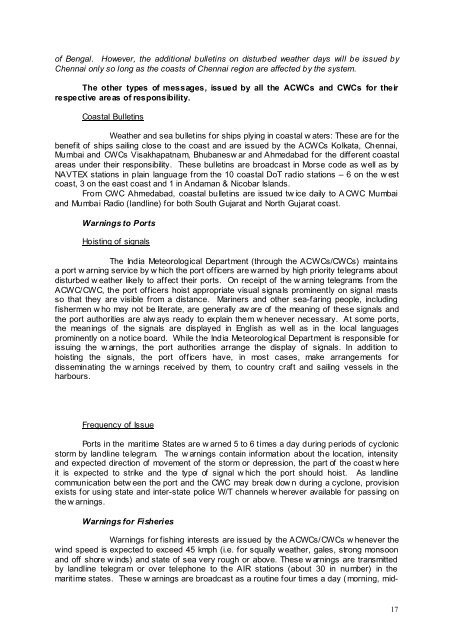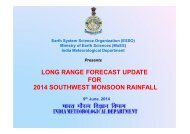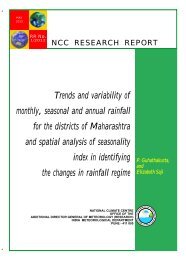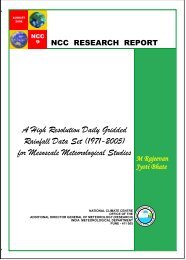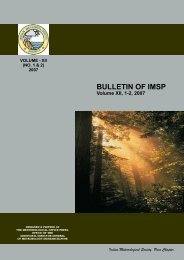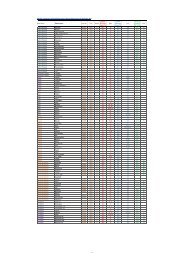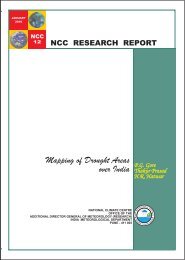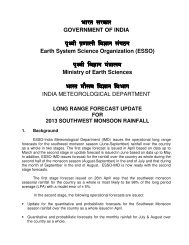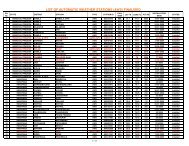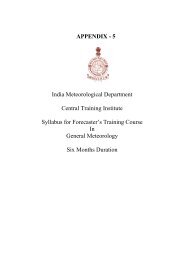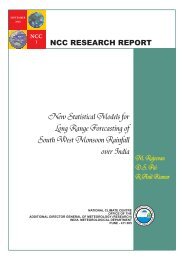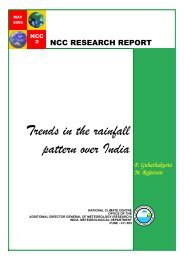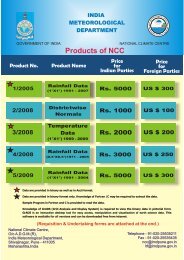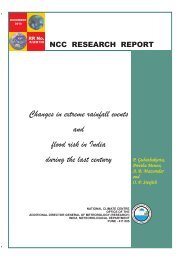Forecasters Guide - (IMD), Pune
Forecasters Guide - (IMD), Pune
Forecasters Guide - (IMD), Pune
Create successful ePaper yourself
Turn your PDF publications into a flip-book with our unique Google optimized e-Paper software.
of Bengal. However, the additional bulletins on disturbed weather days will be issued by<br />
Chennai only so long as the coasts of Chennai region are affected by the system.<br />
The other types of messages, issued by all the ACWCs and CWCs for their<br />
respective areas of responsibility.<br />
Coastal Bulletins<br />
Weather and sea bulletins for ships plying in coastal w aters: These are for the<br />
benefit of ships sailing close to the coast and are issued by the ACWCs Kolkata, Chennai,<br />
Mumbai and CWCs Visakhapatnam, Bhubanesw ar and Ahmedabad for the different coastal<br />
areas under their responsibility. These bulletins are broadcast in Morse code as well as by<br />
NAVTEX stations in plain language from the 10 coastal DoT radio stations – 6 on the w est<br />
coast, 3 on the east coast and 1 in Andaman & Nicobar Islands.<br />
From CWC Ahmedabad, coastal bulletins are issued tw ice daily to A CWC Mumbai<br />
and Mumbai Radio (landline) for both South Gujarat and North Gujarat coast.<br />
Warnings to Ports<br />
Hoisting of signals<br />
The India Meteorological Department (through the ACWCs/CWCs) maintains<br />
a port w arning service by w hich the port officers are warned by high priority telegrams about<br />
disturbed w eather likely to affect their ports. On receipt of the w arning telegrams from the<br />
ACWC/CWC, the port officers hoist appropriate visual signals prominently on signal masts<br />
so that they are visible from a distance. Mariners and other sea-faring people, including<br />
fishermen w ho may not be literate, are generally aw are of the meaning of these signals and<br />
the port authorities are alw ays ready to explain them w henever necessary. At some ports,<br />
the meanings of the signals are displayed in English as well as in the local languages<br />
prominently on a notice board. While the India Meteorological Department is responsible for<br />
issuing the w arnings, the port authorities arrange the display of signals. In addition to<br />
hoisting the signals, the port officers have, in most cases, make arrangements for<br />
disseminating the w arnings received by them, to country craft and sailing vessels in the<br />
harbours.<br />
Frequency of Issue<br />
Ports in the maritime States are w arned 5 to 6 times a day during periods of cyclonic<br />
storm by landline telegram. The w arnings contain information about the location, intensity<br />
and expected direction of movement of the storm or depression, the part of the coast w here<br />
it is expected to strike and the type of signal w hich the port should hoist. As landline<br />
communication betw een the port and the CWC may break dow n during a cyclone, provision<br />
exists for using state and inter-state police W/T channels w herever available for passing on<br />
the w arnings.<br />
Warnings for Fisheries<br />
Warnings for fishing interests are issued by the ACWCs/CWCs w henever the<br />
wind speed is expected to exceed 45 kmph (i.e. for squally weather, gales, strong monsoon<br />
and off shore w inds) and state of sea very rough or above. These w arnings are transmitted<br />
by landline telegram or over telephone to the AIR stations (about 30 in number) in the<br />
maritime states. These w arnings are broadcast as a routine four times a day (morning, mid-<br />
17


